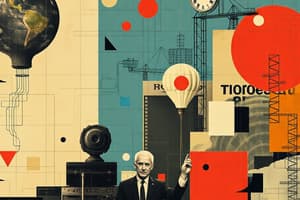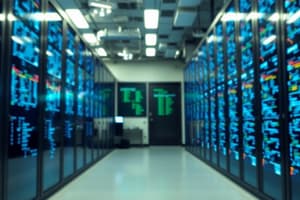Podcast
Questions and Answers
An information system (IS) is a set of interrelated components that collect, manipulate, and disseminate ______ and information.
An information system (IS) is a set of interrelated components that collect, manipulate, and disseminate ______ and information.
data
Businesses can use information system feedback to achieve their ______, increase revenues and reduce costs.
Businesses can use information system feedback to achieve their ______, increase revenues and reduce costs.
goals
In an organization, information is often confused with the term ______.
In an organization, information is often confused with the term ______.
data
Knowledge is defined as awareness and understanding of a set of information and the ways it can be made ______ to support a task.
Knowledge is defined as awareness and understanding of a set of information and the ways it can be made ______ to support a task.
The ______ of an organization’s information is crucial; if it is not accurate or complete, poor decisions can be made.
The ______ of an organization’s information is crucial; if it is not accurate or complete, poor decisions can be made.
A system consists of a set of elements or components that interact to accomplish ______.
A system consists of a set of elements or components that interact to accomplish ______.
The main components of a system include inputs, processing mechanisms, outputs, and ______.
The main components of a system include inputs, processing mechanisms, outputs, and ______.
Efficiency is a measure of what is produced divided by what is ______.
Efficiency is a measure of what is produced divided by what is ______.
Effectiveness is a measure of the extent to which a system attains its ______.
Effectiveness is a measure of the extent to which a system attains its ______.
A system performance standard is a specific ______ of the system.
A system performance standard is a specific ______ of the system.
An Information System (IS) is a set of interrelated elements that collect, manipulate, store, and disseminate data and ______.
An Information System (IS) is a set of interrelated elements that collect, manipulate, store, and disseminate data and ______.
In a Computer-Based Information System (CBIS), the ______ includes all hardware, software, databases, telecommunications, people, and procedures.
In a Computer-Based Information System (CBIS), the ______ includes all hardware, software, databases, telecommunications, people, and procedures.
The activity of gathering and capturing raw data is referred to as ______.
The activity of gathering and capturing raw data is referred to as ______.
The production of useful information, usually in the form of documents and reports, is known as ______.
The production of useful information, usually in the form of documents and reports, is known as ______.
A Management Information System (MIS) focuses on providing routine ______ to managers and decision makers.
A Management Information System (MIS) focuses on providing routine ______ to managers and decision makers.
E-commerce includes any business transaction executed electronically between companies and ______.
E-commerce includes any business transaction executed electronically between companies and ______.
A Decision Support System (DSS) supports problem-specific ______ making.
A Decision Support System (DSS) supports problem-specific ______ making.
Artificial intelligence involves computer systems that take on characteristics of human ______.
Artificial intelligence involves computer systems that take on characteristics of human ______.
Knowledge management systems (KMSs) aim to create, store, share, and use the organization's ______ and experience.
Knowledge management systems (KMSs) aim to create, store, share, and use the organization's ______ and experience.
In specialized systems, ______ systems allow devices to see, store, and process images.
In specialized systems, ______ systems allow devices to see, store, and process images.
Flashcards are hidden until you start studying
Study Notes
What is an Information System?
- An information system (IS) is a collection of interconnected parts that gather, process, and distribute data and information to achieve a specific objective.
- IS can help businesses reach their goals, increase profits, and minimize expenses.
Data, Information, and Knowledge
- Data: Raw, unprocessed facts.
- Information: Organized data that holds value beyond the data itself.
- Process: A series of logically related tasks undertaken to achieve a predetermined outcome.
- Knowledge: Understanding and awareness of a set of information and how it can be used to support a task.
- Information is created when data is processed through a process.
- Knowledge is formed when people interpret information.
Characteristics of Valuable Information
- Accurate information is crucial for avoiding costly mistakes in decision-making.
- Different data types may require different levels of accuracy.
- Valuable information is complete, relevant, timely, and readily accessible.
System Concepts
- A system is a collection of interconnected components working together to achieve goals.
- A system's components include inputs, processing mechanisms, outputs, and feedback.
System Performance and Standards
- Efficiency: The ratio of output to input, measuring productivity.
- Effectiveness: The degree to which a system achieves its goals.
- System performance standard: A specific objective for the system, indicating desired results.
Information Systems
- An information system is a set of interrelated elements that collect, manipulate, store, disseminate data, and provide feedback to meet an objective.
- Information systems convert data into useful outputs.
- The feedback from the system is used to make changes to input or processing.
Computer-Based Information Systems (CBIS)
- Consist of hardware, software, databases, telecommunications, people, and procedures.
- Modern businesses use CBIS to integrate into products and services.
- For example, VW vehicles utilize CBIS to detect errors, provide repair recommendations, check available parts, and schedule service appointments.
Technology Infrastructure
- Is comprised of all hardware, software, databases, telecommunications, people, and procedures.
- Forms the foundation of each CBIS.
Hardware,Software, and Databases
- Hardware refers to the physical equipment used for input, processing, storage, and output.
- Software encompasses the computer programs that control the operation of the computer.
- Database is an organized collection of facts and information typically consisting of two or more related data files.
Telecommunications and Networks
- Telecommunications involve the electronic transmission of signals for communication.
- Networks connect computers and equipment to enable electronic communication.
- The Internet is the world’s largest computer network, with interconnected networks freely exchanging information.
Web, Intranet, and Extranet
- The Web is a network of links on the Internet that contains text, graphics, video, and sound.
- An intranet is an internal network within an organization that facilitates information exchange and project collaboration.
- An extranet is a network that allows select outsiders, such as business partners and customers, to access authorized resources of a company’s intranet.
People and Procedures
- People are the most important element in most CBIS.
- Procedures involve strategies, policies, methods, and rules for using the CBIS.
Business Information Systems
- Electronic and mobile commerce, transaction processing, management information, and decision support are examples of business information systems.
- Special-purpose systems, such as virtual reality, are employed by some organizations.
Electronic and Mobile Commerce
- E-commerce broadly encompasses any business transaction executed electronically between companies, businesses and consumers, consumers and other consumers, and businesses and the public sector, and consumers and the public sector.
- Mobile commerce (m-commerce) involves placing orders and conducting business using mobile, wireless devices.
- E-procurement leverages information systems and the Internet to acquire parts and supplies.
- Electronic business (e-business) utilizes information systems and the Internet to perform all business-related tasks and functions.
Enterprise Systems: Transaction Processing Systems and Enterprise Resource Planning
- A transaction is any business-related exchange, like payments to employees or sales to customers.
- A Transaction processing system (TPS) is a collection of people, procedures, software, databases, and devices that execute and record completed business transactions.
- Enterprise resource planning (ERP) is a set of integrated programs that manage vital business operations for a multisite, global organization.
- ERP systems offer integrated software to support manufacturing and finance.
Information and Decision Support Systems
- A Management Information System (MIS) provides routine information to managers and decision-makers, focusing on operational efficiency.
- MIS generate standard reports using data and information extracted from the TPS or ERP.
- A decision support system (DSS) supports problem-specific decision making, helping managers with complex problems and difficult to obtain information.
Specialized Business Information Systems: Knowledge Management, Artificial Intelligence, Expert Systems, and Virtual Reality
- Knowledge Management Systems (KMSs) are organized collections that create, store, share, and utilize an organization’s knowledge.
- Artificial intelligence (AI) describes computer systems that exhibit characteristics of human intelligence.
- AI branches into robotics for automating complex, dangerous, routine, or boring tasks, vision systems for allowing devices to see, store, and process images, and natural language processing for enabling computers to understand and act on verbal or written commands.
- Learning systems allow computers to learn from past mistakes or experiences, while neural networks enable computers to recognize and act on patterns or trends.
- Expert systems provide computer ability to offer suggestions and function as experts within a specific field.
- Virtual reality simulates a real or imagined environment in an immersive three-dimensional experience.
System Development
- Systems development involves creating or modifying existing business systems.
- Outsourcing allows companies to focus on their strengths while delegating other functions to companies with expertise in systems development.
Systems Investigation and Analysis
- Systems investigation aims to understand the problem needing resolution or the opportunity to be addressed.
- Systems analysis defines the problems and opportunities of the existing system.
Systems Design, Implementation, and Maintenance and Review
- Systems design determines how the new system will operate to meet the business requirements defined during systems analysis.
- Systems implementation involves creating or acquiring different system components, assembling them, and putting the new system into operation.
- Systems maintenance and review continually assess and modify the system to ensure it aligns with evolving business needs.
Information Systems in Society, Business, and Industry
- Information systems fulfill the needs of various organizations and individuals.
- The rapid and widespread use of information systems introduces various threats from unethical individuals.
Security, Privacy, and Ethical Issues in Information Systems and the Internet
- Computer-related mistakes and waste are concerns.
- Ethical issues address what is generally considered right or wrong in information systems.
- Individual privacy is a crucial social issue, with potential for unintentional disclosure, loss, or theft of personal information.
- Many Internet sites collect personal and financial information.
- Social networks can pose challenges in the workplace.
Security, Privacy, and Ethical Issues in Information Systems and the Internet
- To mitigate privacy and data threats, install security and control measures.
- Legislation has been enacted to safeguard individuals from privacy intrusions.
- Utilizing information systems raises workplace concerns involving job displacement due to increased efficiency and potential health problems.
Computer and Information Systems Literacy
- Computer literacy denotes knowledge of hardware, software, databases, telecommunications, and their functionalities.
- Information systems literacy encompasses understanding how and why data and information are utilized by individuals, groups, and organizations.
Information Systems in the Functional Areas of Business
- Companies have functional areas and operating divisions, such as finance and accounting, sales and marketing, manufacturing, human resource management, and legal information systems.
Industry Information Systems
- Industries that effectively employ information systems include the airline and transportation industry, investment firms and banks, publishing companies, healthcare maintenance organizations (HMOs), retail companies, power management and utility companies, and professional services/management consulting firms.
Global Challenges in Information Systems
- Cultural and language differences.
- Time and distance challenges.
- Infrastructure challenges.
- Currency challenges.
- Product and service challenges.
- Technology transfer issues.
- State, regional, and national laws.
- Trade agreements.
Studying That Suits You
Use AI to generate personalized quizzes and flashcards to suit your learning preferences.



